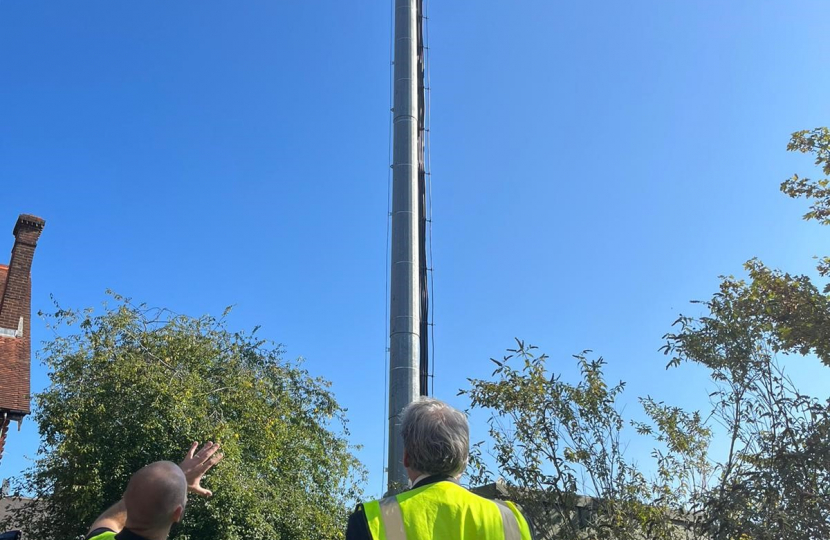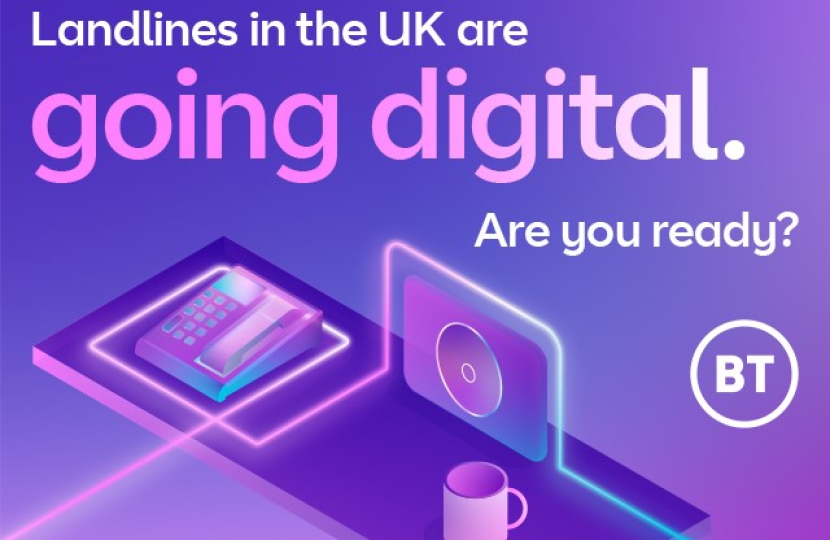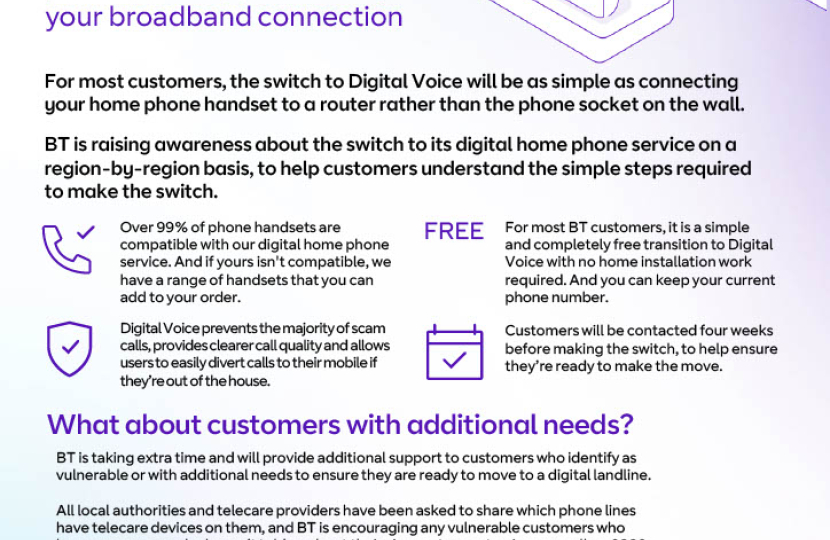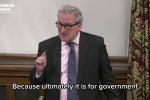The UK's old analogue landline network (otherwise known as PSTN) is being switched off in 2027. What this means is that all devices that currently rely on the PSTN - landlines, care alarms, security alarms, and some basic broadband packages - will need to be moved to a digital connection. We have been working to understand the implications of the switch over to digital and what practical steps people living in East Hampshire will need to take so that they are fully prepared for the change.
We know that some constituents are very concerned about losing their landline and moving to a digital option, particularly those that are subject to frequent power cuts that can last hours, sometimes days (the digital handsets do not work without power). We also know that some constituents have been automatically moved onto a digital contract when their old landline contract has come to an end, sometimes against their wishes. Clearly, there are a number of issues that still need to be resolved.
In February 2025, Damian wrote to the Secretary of State at the Department for Science, Innovation and Technology (the department that has the lead responsibility for the telecomms and broadband sector) to urge him to put better protections in place for those individuals that are currently landline dependent, many of whom live in rural locations such as East Hampshire. The letter can be found below.
If you are concerned about losing your landline, please do get in touch - [email protected]
To help you understand what this all means, we've provided some basic information below:
Commonly used terms
Public Switched Telephone Network (PSTN) – this is the traditional telephone network using copper wires.
Voice over Internet Protocol (VoIP) – this is the method of delivering/receiving voice calls using the internet (also known as 'digital landlines' and 'digital voice')
FTTP – stands for Fibre to the Premises and is ultrafast full fibre broadband. This method uses fibre optic cables to carry broadband directly from the telephone exchange to your property.
FTTC – stands for Fibre to Cabinet and is superfast broadband. This method of delivering broadband uses copper wires.
Project Gigabit - This is the government’s £5 billion programme to provide ultrafast broadband to homes that are not currently within the upgrade plans of the main commercial providers e.g. Sky, Virgin Media etc. This is particularly important for the more rural parts of the community, which are less likely to be covered by commercial providers. Project Gigabit also runs the voucher scheme whereby local residents can apply for government vouchers to fund broadband improvements if they're currently struggling with slow speeds.
CityFibre were awarded a contract by the government (Building Digitial UK or BDUK for short) to provide ultra fast fibre to 70,000 homes in Hampshire. We are currently awaiting the full list of postcodes that will fall within this contract as well as a timetable for implementation (we are hoping to receive this before the end of 2024).
There is some useful background information about the transition here.
Frequently asked questions
What is the analogue switch off and why is it happening?
Over the next few years the way our landlines work is going to change. We currently rely on the PSTN to make and receive calls, but this method will be retired and changed to VoIP as the copper lines are becoming too difficult and expensive to maintain. Also, as the way we receive broadband continues to shift to fibre optic cables, the copper lines are becoming redundant. This change will affect the whole of the UK.
For most people, the switch to digital will be carried out entirely by Openreach and current broadband suppliers, with little or no involvement from consumers.
When will the PSTN be switched off?
The change is expected to be completed by January 2027. Openreach announced their intention to retire the PSTN in 2017. The rollout of BT’s Digital Voice (a new phone service using VoIP) began in 2021 but was paused last year to allow for more time to figure out how to support customers who rely more heavily on landlines (and following a number of problems with migrating individuals with telecare alarms to digital landlines). The deadline for switching off the PSTN has now been extended to January 2027 so that those who need greater assistance in making the switch, including individuals with 'telecare' alarms, have longer to do so.
What is the government’s role in this?
The switch off is entirely industry-led and had not required legislative action from the government. Ofcom are regulating the switch off to ensure the transition is not disruptive and so that vulnerable customers are protected. However, the switch to digital relies on homes having a reliable broadband connection and decent mobile phone signal (more on that below). The government’s role in this is assisting with the rollout of ultrafast fibre broadband to hard-to-reach areas through Project Gigabit.
Will this cost me anything?
The pricing for VoIP services is a commercial matter but BT and Virgin Media have both said that customers will not have to pay more for their digital landline service when the switch off happens.
Any back-up equipment or adaptations to existing equipment that you may require should be provided free of charge by your provider. It's best to contact your provider to find out.
Will I need to purchase broadband connection?
Ofcom reports that around 3% of households used landline only services in 2018. VoIP will require a good internet connection to work and the higher the speed of the broadband, the better the quality of calls will be. However, it will not be essential to have FTTP; VoIP will work using superfast broadband (FFTC). If you don’t currently have a broadband connection, your provider should supply one to you specifically to support the digital landline service. This shouldn’t cost any more if the broadband connection is to support your landline only. This is because the speed of your broadband will not need to be as fast for voice calls as it would need to be for general broadband use.
For those individuals not wanting (or able) to have a new broadband connection, BT will be introducing a new dedicated landline for anybody without broadband in their home. This will not require any in-home changes at all, and it will continue to provide a powered phone line. This is an interim measure until 2030 and will start to become available by the end of 2024. It is likely that other phone providers will follow suit.
Will I get to keep my current handset and telephone number?
Yes. If you would still like to keep a landline you can keep your current handset and in most cases you will be able to keep your number. Your existing handset will need to be plugged directly into your router for VoIP to work. Your provider should supply you with an adapter for your handset if you cannot plug it directly into your router.
If you use cordless phones in your home, you will need only one adapter. If you use traditional corded phones, you will need an adapter for each phone.
Why do landlines using the PSTN work during a power cut but those using VoIP won’t?
A traditional analogue phone works during a power cut because the PSTN uses power from the local telephone exchange, which has a back up generator. Telephone exchanges also tend to be underground and not as susceptible to extreme weather as exposed power lines.
When the switch over takes place, your digital landline will no longer work in a power cut and nor will any devices connected to it e.g. medical emergency alarms. This is because for VoIP to work, there must be an internet connection provided by a router. A router requires mains power to work. This is why it will be important to ensure that there is a good mobile signal across the whole of East Hampshire before the analogue line is switched off.
What is being done to help people who rely on their landlines?
Individuals who are dependent on a landline (such as those who do not have a mobile phone) will be offered a back up solution so that they can contact emergency services during a power cut. This is a requirement set by Ofcom. This solution could be a battery back-up unit for the digital landline phone or a mobile phone or 'hybrid' phone if you do not already have a mobile. There are a number of phone operators, for example Virgin Media O2, who already offer emergency back up lines to their customers with a full charge lasting approximately eight hours. This device has a SIM card inside and is connected to the router and phone, so if there is disruption to power, the device will activate and the customer can continue to use their home phone to contact emergency services (this solution though relies on a good mobile signal to work). Obviously, in areas where there is little or no network coverage, any kind of mobile or hybrid phone is not going to work as an emergency back up phone. This is an area that Damian continues to campaign about.
See Virgin Media O2's and BT's latest guides for consumers below.
What if my mobile phone does not have reliable network?
This is a crucial issue that is critical to the success of the switch over to digital. It's well documented that there are parts of East Hampshire, and indeed other rural parts of the country, where mobile phone coverage is patchy at best and certainly not reliable. The mobile phone operators have plans over the next few years to upgrade existing masts in East Hampshire to improve 4G and 5G coverage. The old 3G network has been switched off although, importantly, the 2G network will continue for another 10 years (2G carries calls and texts).
It's worth remembering that in the event of an emergency, you can dial 999 from your mobile phone and it will connect to the best signal locally (even if this isn't your own mobile phone provider).
Damian continues to raise this matter with mobile phone providers to find out what else can be done to improve the signal across the constituency. He has met with Vodafone, BT EE and Virgin Media O2 to understand their plans to upgrade their mast signals in the constituency (including their collective work on the shared rural network - see below) as well as how they will be supporting their customers as they move them over to VOIP. There is a very real possibility, though, that improvements to the mobile phone network will not be in place before the landline is switched off in 2027 - potentially leaving many individuals digitally 'marooned'.
Virgin Media O2 estimate that half of the population will have 5G by the end of 2024.
What other equipment relies on the PSTN?
Other devices, such as telecare medical devices, security alarms, CCTV and traffic lights, all rely on the PSTN. The government is working with relevant sectors to ensure customers and providers of these devices are prepared. For instance, the Department for Health and Social Care published a telecare stakeholder action plan.
The government published new guidance on 19 November 2024 to protect elderly people relying on personal alarms during the switch over from analogue to digital landlines. This means that an engineer will need to physically visit a vulnerable customer to test that the alarm is working on the digital network before giving it the green light. More information here:
If you are at all concerned, it's worth contacting the manufacturer of your device to see how they can support you during the switch to VOIP.
Some companies encourage vulnerable customers to register for extra support in the event of an emergency. For example, the electricity provider, SSEN, has a priority services register to identify customers who may need additional help during a prolonged power cut. e.g. by providing back up power for those customers reliant on medical equipment. It's worth registering now for these services.
What is the Shared Rural Network?
This was introduced to try and eliminate the number of partial and total 'not spots' in rural areas by encouraging providers to share mast infrastructure. Partial 'not spots' are areas where mobile signal is available from just one mobile phone provider. Total 'not spots' are areas where there is no signal at all. By using existing infrastructure or sharing new infrastructure, the signal for all mobile customers should be improved. The impact on the local environment is also reduced by fewer masts needing to be erected in the countryside. The network is a funding partnership between the providers and government, which aims to get 4G to 95% of the UK.
I currently have FTTC broadband (and it doesn't look like my area will be upgraded to ultrafast broadband by 2025), will my broadband still work once the analogue line is switched off?
Yes. VoIP services can be provided using any broadband technology, including existing FTTC - this uses copper wires to carry signals from cabinets (normally positioned somewhere on your road) to your house. These are the same copper wires that are used for PSTN landlines but switching off the analogue signal will not affect the broadband connection.
Do I need to do anything ahead of these changes?
When it is time for the switch to happen, you should be contacted by your provider and, at this point, you should talk to your provider about your needs and how this change will affect you. For most people, this change will all be carried out by the provider with little disruption to you.
Ofcom recommends that customers start talking to their provider now if they:
- have other devices which rely on the PSTN;
- would be unable to access emergency services in the event of a power cut (for instance, if they do not have a mobile phone or a reliable mobile signal): and/or
- have a disability or any other needs that will require assistance with installation.
Ofcom has stated that service providers should seek to identify customers who rely on other devices that use PSTN.
Below are a few of the industry guides on the transition to digital voice. It's worth looking at the website of your mobile phone provider for more information, particularly if you are a vulnerable customer.
Vodafone's guide can be found here: Your landline is changing: Everything you need to know










